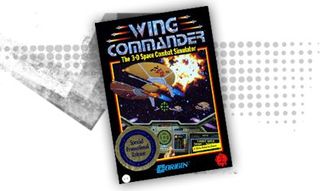DRM = FUN
We look back at the good old days of copy protection
Instead, we’d like to invite you to sit back, relax, and remember the halcyon days of copy protection with us, the ones ruled by lensloks, code wheels, and tricky trivia questions that sent you foraging through your well-worn manuals.

When it comes to crazy copy protection contraptions, you won’t find anything more kooky or old school than the lenslok. These foldable prisms were introduced to the gaming public in 1984, when Elite, a space trading game for the ZX Spectrum was released.

Above: Who would’ve guessed that Isaac Newton’s theories on prisms would help future game developers create ridiculous copy protection contraptions?
Elite would prompt the user to break out their lenslok midgame and hold it up to the screen in order to decipher an otherwise unreadable code. Did it prevent piracy? Probably not. The lenslok was only designed to decipher codes that were two characters long. A bit of patience was all it took crack the code, and once you did, the same one could be re-used every time you played.
Still, we have to give it up for the lenslock. This cumbersome device is now a valued piece of kitsch, treasured by geriatric gamers and collectors of arcane relics.

Above: Lines and numbers! Elite’s influence can be felt in more modern software like EVE Online and Microsoft Excel

Remember when games asked you to enter the fifth letter on the third paragraph on page eight of the manual to make sure you weren’t playing a pirated copy? Yeah, we hated that too. But there were a few memorable games that managed to get creative with the way they used the manual to ensure you owned a legitimate copy.
Sign up to the GamesRadar+ Newsletter
Weekly digests, tales from the communities you love, and more
Our favorite: Origin System’s Wing Commander. Instead of sending you on a soulless word hunt through the game’s manual, Wing Commander peppered you with fun trivia about the game’s lore and specifications of its various ships. Thanks to Wing Commander’s manual questions, we’ll always remember that the Fralthi has 28 cm of front armor and that the Ralari weighs 18,000 tons.

Most Popular





